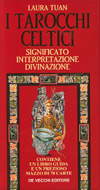

I Tarocchi Celtici (The Celtic Tarot) by Laura Tuan
Published by: de Vecchi Editore (Italian)
available from Alida.
reviewed by: David Bruce Albert Jr., Ph.D. ([email protected])
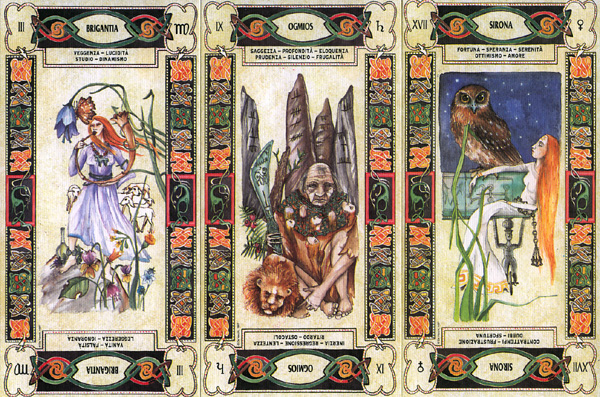
Maybe it's just me, but when I think of the Tarot, it conjures up images of a warm Mediterranean climate -- of richly adorned parlors, happy and carefree carnivals, and maybe the dark woods of Romany and mysterious gypsy fortune tellers. Anything but the cold, craggy highlands and fog-shrouded seashores that were the strongholds of the Celtic people. From a philosophical standpoint, the Tarot also suggests superconsciousness, archetypes, and the aspiration of human consciousness to spiritual union, while the Celtic spirit seems more at home with the runes and the Oghams, peering into ritual bonfires, and consulting (and consorting) with the etheric creatures of the forest.
Apparently it isn't just me, because the modern Celtic revival has spawned not only an interest in the culture and spiritual practices of those ancient peoples, but also an interest in adapting other methods of ritual and study to their beliefs and cultural paradigms. This is no where more clearly seen than in the appearance of a number of "Celtic" tarot decks in recent years. Most authors have discovered, however, that to adapt the Mediterranean Tarot to the Celtic temperament, certain alterations must be made. One of the most successful adaptations of the Tarot to a Celtic framework is the Sacred Circle, reviewed elsewhere on this site, whose authors found it necessary to rename and rearrange several of the Major Arcana cards in order to produce an oracle that speaks in Celtic imagery.
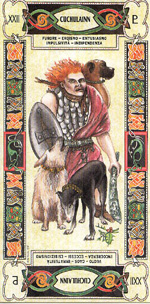
I Tarocchi Celtici by Laura Tuan, published by de Vecchi Editore, is an ingenious adaptation of the classical Tarot to the ancient Celtic symbolism of trees and seasons. Before going into the details, I should mention that the deck and its accompanying book -- and a book it is, at 175 pages -- are all in Italian. I do not know of any available English translations at this time. If you find the deck interesting, that should not be a deterrent. It is still a Tarot deck, albeit highly modified, and if you have any experience with the Tarot you already have a general idea of what the cards mean. You can -- and should, if you plan on collecting and/or using any of the many beautiful Italian decks -- get a dictionary that will at least allow you to translate the keywords. A Langenscheidt's Pocket Dictionary for just about any language in the world can be bought for around $10, and has most of the words you will encounter in using the Tarot (though see the end of this review for one amusing exception). A dictionary alone won't translate the entire book, but you can figure out a great deal from general subject knowledge and a few key words.
The deck itself comes in heavy cardboard wrap-around box, with a bright red cover and gold-embossed lettering that impresses you with the elegance of this product. The book looks like a paperback novel, and has background information on the Celtic people, mythology and legends, numerology, Oghams, and the lore of the seasons and trees. There is a complete description of each card for the Major and Minor Arcana, along with divinatory significance and a consiglio or piece of advice for the person drawing the card. Finally, there are suggested layouts for using the Major Arcana alone, and for the entire deck. The cards themselves are long and thin, about 8x16 mm or 3-1/8 x 6-1/4 inches, and do not appear to have a plastic coating, so take care. The backs are a green marble-like design, and are not reversible, though you have to look very carefully to notice the difference. They have a rough texture that looks like an oil canvas.

The Major Arcana cards themselves are similar to most Tarot decks. Each card depicts a Celtic god, goddess, or legendary figure, against a cream-colored background. There are no labels such as "Empress" or "Death" on the cards; the name of the entity pictured appears at the top and bottom of the card, along with the astrological symbol of the card, and keywords for upright and reversed interpretations. This means that the occasional transposition of cards from what you might expect does not cause any confusion in actual use. For example, Brigid (Brigantia) is number 3, who I would have guessed would be the Priestess (and the keywords seem to support this guess), while Damona/Morrigan appears as number 2, who I would have assumed to be the Empress. As I have noticed with several Italian decks, the cards are also numbered in sequence from 1 to 78, with the Fool -- a very wigged-out looking Cuchulainn -- being number 22 in this deck.
The Minor Arcana is where this deck stands out from the other "Celtic" decks currently available. It is divided into four suits of 14 cards each, like the usual arrangement, but that is where the similarity ends. Each suit corresponds to one of four seasons, and the background on each card is colored according to the season. The "ace" depicts the major festival that opens the season, and the remaining 13 cards are assigned to the tree and Ogham symbol for the 13 lunar months. For example, the "ace" of spring is colored green, corresponds to the Ogham OHN ("Ginestra", or gorse), and shows a sylph cuddling the lambs associated with the festival of Imbolc, along with a candle calling to mind the later name of the festival, Candlemas. The following table shows the correspondences for the Minor Arcana:
Suit Color Element Elemental Festival Ace
Spring green air sylph Imbolc OHN/gorse
Summer yellow fire salamander Beltane UR/heather
Autumn rose earth gnome Lughnasad EADHA/white poplar
Winter blue water undine Samhain AILIM/silver fir
The remaining cards follow the sequence: Beth, Luis, Nion, Fearn, Saille, Hualt, Druir, Tinne, Coll, Muin, Gort, Ngetal, Ruis. The spellings are in some cases a little different than what you have seen elsewhere, as is also true on some of the Major Arcana ("Cerumno" instead of Cernunnos). As with the Major Arcana, each card has keywords for upright and reversed meanings, along with illustrations that suggest, but do not always directly express, the meaning of the card.
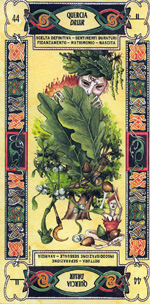
I am not sufficiently knowledgeable about art to identify the style of the artwork, but I can say that this is one of the most beautiful decks I have ever seen. If you have grown tired of the "standard" glossy imagery found on most Tarot products, this deck will be a welcome treat.
You must keep in mind, however, that because this Tarot uses the symbology of the Ogham and the seasons, its energy dynamics are very different from the "standard" cabalistic-derived decks you are probably familiar with. The connections with spirituality and superconsciousness are there via the Major Arcana, but the Minor Arcana invokes energies totally foreign to the "standard" Tarot. For those who are interested in earth-type energies, this is probably for the better, as the "standard" Tarot all but ignores these forces. It does, however, require a certain amount of re-orientation in reading. The other thing you need to keep in mind is that by eliminating the court cards or "dignitaries", human-caused events and forces are under-represented in this deck. Again, that might be for the better for some readers and situations. Given its portrayal of elemental and seasonal energies, this deck is probably the best for use in the kinds of reading that take place during major and minor festivals, as well as lunar observances.
Along those same lines, it would (in theory, of course) be a very effective tool for ritual concentration by those who (only in theory, of course) seek participation in the natural and spiritual forces that the ancestral Celts honored and communicated with in their rites. In other words, if you are looking for an Earth magic Tarot, here it is. The ancients had their gods, goddesses, and legends through whom they experienced superconscious energies, as well as their earth spirits and oracles, through which they maintained their connections with nature. Most of this latter connection has been severed by the urban mode of living, and is also ignored by many of the modern "spiritual" disciplines. It is only through connection with both spirit and earth that we can hope to live in a sustainable relationship with the environment. This Tarot draws attention to those all-but-forgotten forces that nurtured and sustained the minds of the ancients.
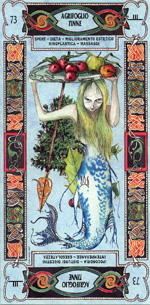
Which brings us to another issue. Participation means that you are as much a part of nature as the sun and the moon, with just as much right to express your own identity and will as any other. I have heard it said by all too many that "magic is evil because it is controlling," which I take to mean that the only acceptable role for the individual is that of victim. Wrong. Magic is as much participation as is anything else. I suspect hidden agendas, or weak and oversocialized personalities here. You are a part of the universe and you might as well get used to it, and if that means asserting yourself against injustice and stupidity, so be it. The only real evil you are likely to commit -- without serious concentrated effort -- is abandoning yourself and your own consciousness to mindless oversocialization and leveling your own mind through idiotic psychobabble and "interpersonal relationships." Don't do that; that is what participation, and the natural and spiritual forces of the universe, are there to prevent. The purpose of mythology, as Joseph Campbell once said, is to keep the individual from being destroyed by culture, and the purpose of magic is to keep the "I" from dissolving into the "we."
Symbolic systems such as the Tarot, and particularly this Tarot, can help re-establish the connections between your own psyche and the natural and spiritual forces that once spoke to and through our ancestors. It is not necessarily an easy process, and the results might not be what you expect. Nor do the cards necessarily reveal the energies you expect. In this deck, for example, the holly (Tinne) in the suit of winter shows a lovely mermaid bearing a platefull of delicious looking fruit. Now, if I were the Holly King at the height of my reign, I would certainly expect my meals delivered by such a lovely creature. But, the keywords advise us to get "rinoplastica", which as nearly as I can translate it, means "nasal surgery". Why would the Holly King want a nose job at the height of his power? Well, maybe after twelve nights of drunken reveling, he gets into a fight or falls over in a stupor? OK, I guess I can accept that.